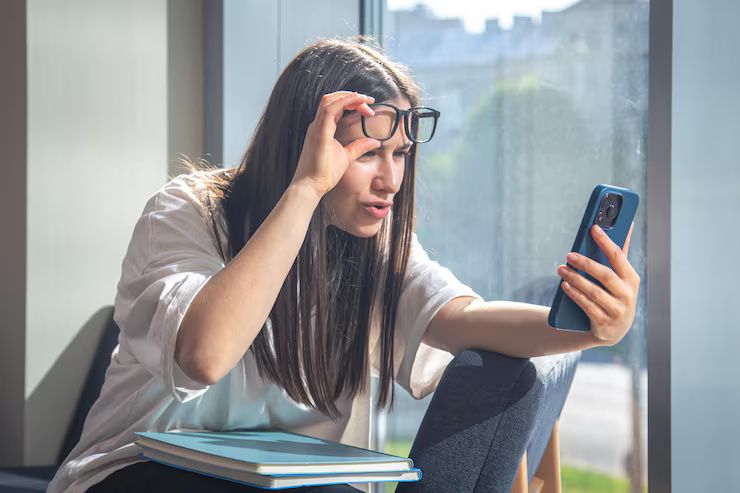Tips to reduce the impact of screen time on eye health
In the digital age, screens are everywhere—computers, smartphones, tablets, TVs. Whether for work, education, or entertainment, many of us spend 6 to 10 hours a day in front of screens. This prolonged exposure can lead to digital eye strain, also known as Computer Vision Syndrome (CVS), affecting both eye health and overall well-being.
While it's hard to avoid screens entirely, there are effective steps you can take to minimize their impact on your eyes. This article shares evidence-based, practical tips to help reduce digital strain and protect your vision.
Why screen time affects your eyes
Your eyes work harder when viewing digital screens because:
-
You blink less, which dries out your eyes
-
You focus for long periods without breaks
-
Bright light and glare increase visual demand
-
Improper posture and lighting can worsen discomfort
Symptoms of digital eye strain include:
-
Blurred vision
-
Dry or watery eyes
-
Headaches
-
Eye fatigue
-
Neck and shoulder pain
Children and adults alike are at risk, especially with increased online schooling and remote work.

Effective tips to protect your eyes from screen-related damage
Follow the 20-20-20 Rule
Every 20 minutes, look at something 20 feet away for at least 20 seconds.
This allows the eye muscles to relax and reduces fatigue caused by constant close focusing.
Adjust screen brightness and contrast
-
Ensure your screen brightness matches your surrounding lighting.
-
Use night mode or blue light filters, especially in the evening.
-
Avoid using screens in total darkness or direct sunlight.
Maintain the right screen distance and angle
-
Keep your screen 20–28 inches (about arm’s length) from your eyes.
-
The top of your screen should be at or just below eye level to reduce strain.
-
Use ergonomic furniture or adjustable stands to achieve this.
Blink more often and consciously
People blink 50% less when using digital devices. This can dry out the eyes and lead to irritation.
Make an effort to blink fully and often, especially when reading or watching long content.
Use lubricating eye drops if needed
If you experience dryness, artificial tears or preservative-free eye drops can help keep your eyes moist. Always consult an eye doctor before prolonged use.
Limit continuous screen time
-
Take short breaks every 30–60 minutes
-
Switch to audio formats (like podcasts) when possible
-
Avoid unnecessary screen use after work or before bed
Improve your screen setup
| Setting | Recommendation |
|---|---|
| Lighting | Use soft, indirect lighting to reduce glare |
| Font Size | Increase text size for comfortable reading |
| Display Quality | Use high-resolution screens to reduce strain |
| Anti-glare Filter | Apply screen protectors or use matte screens |
Wear the right eyewear
If you wear glasses, consider
-
Anti-reflective (AR) coating to reduce glare
-
Blue-light blocking lenses to filter high-energy visible light
-
Prescription adjustments for screen distance (computer glasses)
Tip: Have your prescription checked regularly if you use screens for long hours.
Get regular eye check-ups
Even if you don’t have vision problems, annual eye exams are essential. An optometrist can:
-
Identify early signs of eye strain
-
Recommend suitable eye protection
-
Adjust your vision prescription based on digital habits
Tools and apps to reduce screen-related eye strain
| Tool/App | Function |
|---|---|
| f.lux | Adjusts screen color temperature by time of day |
| Eyeleo | Reminds you to take eye breaks periodically |
| Iris | Offers advanced screen brightness control |
| Time Out (Mac) | Pauses screen activity for short breaks |
| Windows Night Light | Built-in blue light reduction tool |
FAQs
1. Is blue light really harmful to the eyes?
Blue light from screens doesn’t damage the eyes directly, but it can disrupt sleep and contribute to eye strain, especially at night. Using blue light filters or night mode helps reduce this effect.
2. Can too much screen time cause permanent vision damage?
There’s no evidence that screen time causes permanent damage, but it can lead to chronic discomfort and uncorrected vision issues if not managed properly.
3. Are blue-light glasses effective?
Studies are mixed. While some users find them helpful for reducing glare and improving sleep, others see little difference. They’re generally safe to try.
4. How can I help my child avoid screen-related eye problems?
Encourage regular breaks, limit recreational screen time, and ensure proper lighting. Teach them the 20-20-20 rule early.
5. Is it better to use a larger screen instead of a phone?
Yes. Larger screens usually offer better resolution, larger text, and allow for better posture, all of which help reduce strain.
Final thoughts
In a world where digital devices are essential, protecting your eye health is more important than ever. With simple daily habits—like blinking more often, taking breaks, and adjusting your screen—you can minimize digital eye strain and maintain healthy vision.
Remember: Your eyes are irreplaceable. Small changes today can prevent major discomfort tomorrow. If you experience ongoing symptoms, consult an eye care professional for a personalized solution.
